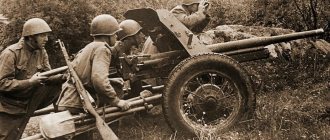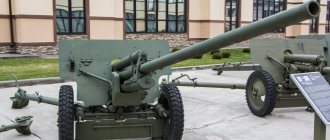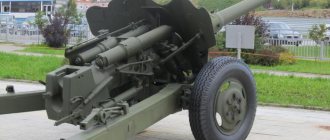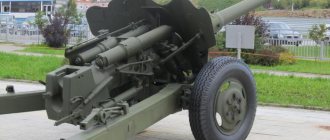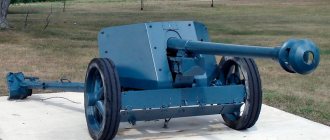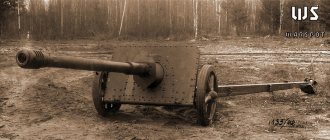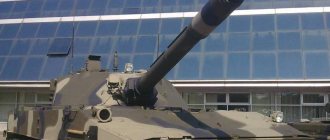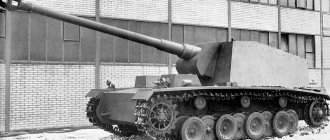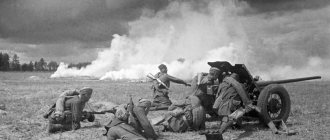Home » Literature on the history of artillery » 45-mm anti-tank gun of the Red Army
Literature on the history of artillery
boroda 11.09.2021 1589
18
in Favoritesin Favoritesfrom Favorites 4
Perhaps the most famous, along with the ZiS-3, is the Soviet anti-tank gun. I came across a very interesting and detailed article about her in Yandex-Zen. I present it to your attention.
Product N165 45-mm anti-tank gun – “Leningrad Front”
Soviet anti-tank artillery played a vital role in the Great Patriotic War, accounting for about 70% of all German tanks destroyed. Anti-tank warriors, fighting “to the last”, often repelled Panzerwaffe attacks at the cost of their own lives.
The 45-mm anti-tank gun model 1937 (PTP) was the main weapon of the Red Army at the initial stage of the Great Patriotic War.
Guns of this caliber remained the basis of Soviet anti-tank artillery throughout the first period of the war. During the days of the Battle of Stalingrad, they accounted for up to 43% of all guns in service with our anti-tank destroyer regiments. And it is no coincidence that one of the German generals, Friedrich Wilhelm von Mellenthin, wrote: “Sometimes you think that every Russian infantryman has an anti-tank rifle or an anti-tank gun. The Russians are very skillful in disposing of these means, and it seems that there is no place where they are not there.”
Its history began in 1930, when Soviet specialists purchased from the Germans licensed samples of the 37-mm 3.7-cm PaK 35/36 anti-tank gun along with technical documentation. A year later, by order of the Revolutionary Military Council, it was adopted and put into mass production. The same gun was produced in Germany under the designation Pak.35/36. In 1932, a group of engineers led by G. Bering, in order to increase armor penetration, significantly modified the gun by placing a 45 mm barrel on an improved 37 mm gun carriage.
After factory tests, it was sent to the research artillery range (NIAP). During the tests in August - September 1937, 897 shots were fired, 184 of them from concrete. The system was tested by cart over a distance of 684 km. The PTP passed the shooting tests.
In November 1937, Plant No. 8 produced a pilot series of 6 45-mm guns, which differed from the guns mod. 1932:
- The semi-automatic shutter worked both with an armor-piercing projectile and with a fragmentation projectile, and for the mod. 1932 only with armor-piercing. This was achieved by forced cocking of the semi-automatic springs at the moment of firing;
- a special push-button release was introduced from a button located in the center of the steering wheel of the lifting mechanism;
- crank-spring type suspension was introduced, first implemented in the USSR in this system;
- instead of wooden wheels PTP arr. 1932 ZIK-1 automobile wheels from GAZ-A with minor changes in the spokes and filled with sponge rubber were supplied;
- the upper machine was a riveted-welded structure made of sheet steel, and the PTP arr. 1932 the upper machine was cast;
- a new rotating mechanism has been introduced;
- New design lower welding machine.
At the beginning of 1938, military tests of three 45-mm 53-K guns with Y-3 gun limbers were carried out. The gun was put into service under the name 45-mm anti-tank gun mod. 1937 On June 6, 1938, it was launched into mass production.
Here is an excerpt from a document of the Main Artillery Directorate of the Red Army, which describes the purpose of the 45-mm anti-tank gun 53-K: “The 45-mm anti-tank gun of the 1937 model is a powerful anti-tank weapon of the cavalry and rifle units of the Red Army, which is capable of successfully fighting modern tanks of any kind. types." In addition to its main purpose (destroying tanks), the gun, which is armed with buckshot and fragmentation shells, can successfully destroy enemy firing points located behind light shelters, infantry and cavalry operating in open areas.
The gun, being in service with rifle units, must accompany the infantry during all periods of battle, relentlessly following it, shooting at enemy firing points with direct fire. The main combat qualities of the 45-mm anti-tank gun are: maneuverability and mobility, rate of fire, armor penetration, and flat trajectory. The gun can be transported by mechanical traction (car or Komsomolets tractor), as well as horse traction. The passages of the gun's limber and carriage are reliably sprung, which allows the following speeds when moving by mechanical traction: on tarmac - 50-60 km/h, on good quality dirt roads - 40-45 km/h, on cobblestone roads - 30-35 km/ h.
The rapid execution of assigned fire missions is ensured by the trouble-free operation of the gun. To ensure trouble-free operation, excellent training in calculating the implement, strictly coordinated work, interchangeability of its numbers in case of decline, and excellent knowledge of mat are required. gun parts, as well as timely replenishment of ammunition. The compact design of the gun and the low shield cover make it an inconspicuous target on the battlefield - the gun is 120 cm high and 402 cm long. To make the gun easier to camouflage, the shield cover is foldable. The gun was used mainly for direct fire at armored targets and enemy firing points at a range of up to 1.0-1.5 km. When shooting at long distances, monitoring the results of shooting is difficult due to the small size of the projectile explosion cloud.
To fire from a 45-mm anti-tank gun of the 1937 model, armor-piercing and armor-piercing tracer shells were used to fire at tanks, armored vehicles and embrasures of fire structures. At a range of 500 m at a meeting angle of 90°, they penetrated armor 43 mm thick, and at a range of 1000 m - 32 mm. A sub-caliber projectile at a distance of 500 m at an impact angle of 90° penetrated armor 66 mm thick, and at a distance of 100 m - 88 mm. During the first year of the war, these indicators were quite sufficient to combat all Wehrmacht tanks. The fragmentation grenade was intended for firing at manpower and openly located firing points. When a grenade explodes on the surface of the ground, it produces about 100 lethal fragments, capable of causing damage over an area of up to 15 m along the front and up to 5-7 m in depth. Cartridges with buckshot were used to repel infantry attacks on the gun's firing position at a distance of up to 400 m. Buckshot consists of bullets placed in a special casing in a cartridge case. When fired, bullets fly out of the barrel at a certain angle and hit enemy forces to a depth of up to 400 m and along the front up to 60 m. In addition to these shells, armor-piercing chemical and smoke shells were also produced in the pre-war years. Armor-piercing chemical shells were intended to poison tank crews and garrisons of long-term firing points. The armor-piercing chemical projectile weighed 1.43 kg and contained 16 g of a highly active toxic substance.
Already in the first days of the war, the Nazis felt the hard way what a forty-five was worth in the skillful hands of Russian soldiers. The battery of junior lieutenant Logvinenko, in which Sergeant Ivan Panfilenok served as the gun commander, met the 13th Wehrmacht Panzer Division near the town of Zaturtsy in the Lokachinsky district of the Volyn region, 20 kilometers west of Lutsk.
The guns of Sergeant Moskalev, Sergeant Moskvin and Junior Sergeant Lazorev were camouflaged next to the highway, and Sergeant Panfilenok’s forty-five was placed a little further, in a notch on the ridge of the hill.
The battle began at 14.10. After 20 minutes, 30 tanks were burning on the battlefield, but three of the four guns were destroyed along with their crews. There was only one thing left. Ivan Panfilenok was left alone against several dozen tanks. The Germans went wild with anger. The sergeant fought for about another hour. Slipping on spent cartridges, again and again he deployed the five-hundred-kilogram cannon, pointed it at another tank and set it on fire. When the sight was torn off by a shell fragment, he began to aim through the gun barrel. A 28-centimeter long shell fragment hit his right side, but in the heat of battle the hero did not feel wounded.
At approximately 15.20 the tanks turned around and began to retreat, leaving the gun's kill zone. In that battle, Sergeant Ivan Mikhailovich Panfilenok’s gun destroyed 23 tanks, 17 of which he personally knocked out. The second most effective gun was the gun of Sergeant Nikolai Moskalev, which knocked out 12 enemy tanks that day. In total, in that battle the Germans lost 43 tanks out of 147 that were part of the 13th Panzer Division as of June 22, 1941. Ivan Mikhailovich learned that the tanks in his area could not get through in the hospital from the commander of the 1st artillery anti-tank brigade, Major General of Artillery Kirill Semenovich Moskalenko, who personally came to visit the hero. The advance of Kleist's tank group was delayed for more than a day. Destroying the “major center of Bolshevik resistance,” German planes continued to carefully change the landscape of the area for a long time.
Good experience in fighting enemy tanks began to emerge by mid-1943 (although the highest results were achieved by individual artillerymen at the beginning of the war). By that time, the artillery headquarters of the Red Army, the artillery headquarters of the fronts and armies had put on a permanent basis the study of enemy armored vehicles, their tactics of action, and the issuance of recommendations to the troops. Particular attention was paid to ways to combat new types of heavy tanks and assault guns, such as the Tiger, Panther, and Elefant. Targeted combat training was organized in anti-tank units. The armies equipped special rear training grounds where anti-tank crews trained in shooting at mock tanks, including driving ones. Tank destroyer teams were created. Leaflets were published: “Memo on fighting Tiger tanks”, “Memo to an artilleryman - a destroyer of enemy tanks”.
The artillerymen, the defenders of our glorious hero city Leninrad, also covered their names with unfading glory.
Before the war, anti-tank guns were not produced in Leningrad. City enterprises began to look for opportunities to set up new production. According to the head of the collections department (scientific processing and storage of exhibits) of the Military Historical Museum of Artillery, Engineering and Signal Corps of the Ministry of Defense of the Russian Federation, Candidate of Technical Sciences Ruslan Chumak, “it was an accident that came to the rescue, as often happens.” In the city at plant No. 174 named after. K.E. Voroshilov discovered a stock of unused components for tanks that had ceased to be produced, including 45 mm tank guns. Almost 1.5 thousand tank guns were collecting dust in the plant’s warehouses.
Initially, they were planned to be melted down, but for some reason this decision was delayed, which became an unexpected and very timely find. Using the base of a tank gun, turning it into an anti-tank gun is not as simple a task as it might seem at first glance. After all, the function of the carriage is initially performed by the tank turret, and there is no carriage as such; it was necessary to develop a new carriage, which had to meet a fairly wide range of requirements: allow the barrel to be aimed horizontally and vertically, have a sight, wheel travel, and a towing device. In terms of production, the weapon should have been based solely on the capabilities of the Leningrad industry available at that time; in other words, it should not have required complex equipment or significant inputs of raw materials for its production. Leningrad engineers took this problem very seriously: several projects for a new gun were developed. As a result, Nikolai Antonov’s project was approved, and the gun received an unspoken name - “45-mm anti-tank gun model 1941.” Of course, this designation is not entirely correct, since the cannon was not officially adopted by the Red Army. To do this, it would be necessary to conduct large-scale tests and coordinate a large number of documents, and the front needed guns as soon as possible. Therefore, despite the documented “illegitimateness,” the gun went into production,” notes Ruslan Chumak.
The production of the gun was entrusted to the NKV plant No. 7 (Frunze plant). The front received its first guns by the beginning of August. It is noteworthy that their production was documented only at the end of August. In Resolution No. 187 of the Military Council of the Northern Front, the gun received the designation “45-mm simplified anti-tank gun on a wheeled carriage,” and on . The soldiers also affectionately called it “Leningradka”. The gun was made with a special cart for the convenience of transporting a team of horses and moving ammunition, and together with it it was delivered to the troops. The simplified design made it possible to launch production in a short time. According to the Artillery Directorate of the Leningrad Front, 155 7-33 guns were manufactured in August 1941, and 446 in September. However, in November, due to a particularly difficult period of the blockade, when the military industry in the city almost completely froze, it was possible to manufacture only 48 guns. The 7-33 gun fully coped with its purpose, ensuring the destruction of all enemy tanks and their firepower no worse than the standard 45-mm anti-tank guns of the 1937 model. About 100 7-33 guns were even sent to Moscow, where they took a direct part in the defense of the capital, showing quite high performance.
The efforts of Leningrad gunsmiths turned out to be very timely. During 1941-1942 The 7-33 guns almost completely covered the Leningrad Front’s need for anti-tank artillery. The guns were in service with the troops until 1944. After the blockade was lifted, the troops began to be supplied with new types of artillery from military factories located in the interior of the country.
The legendary 45-mm anti-tank gun of the 1937 model, as well as a rare gun limber with a charging box for it and a GAZ-67V car towing them, were found, restored and brought into perfect collectible condition on the instructions of the customer for a unique exhibition, extremely remarkable not only in aspect of collecting, but also as the most valuable exhibits - participants in ceremonial events dedicated to the removal in January 1944. the siege of our home hero city of Leningrad.
According to the customer’s technical specifications, all exhibits were painted with winter camouflage paint, which was used by Red Army soldiers on the Leningrad Front in the winter of 1944, in a ceremonial glossy version.
Specifications:
- Caliber, mm – 45;
- Barrel length, m (calibres) – 2.07 (46);
- Weight in combat position, kg – 560;
- Weight in stowed position, kg – 1200;
- Length of the gun with the frames moved, mm – 4020;
- The width of the gun with the frames shifted, mm – 1634;
- Practical rate of fire, rds/min – 15-20;
- Maximum firing range, m – 4400;
- Direct shot range, m – 850;
- Initial speed of an armor-piercing projectile, m/s – 750;
- Weight of armor-piercing projectile, kg – 1.43;
- Circulation, units – 37354;
- Years of production: 1937-1943.
The history of the creation of the universal 45-mm gun 21-K
At the end of the 1920s, the leadership of the USSR decided to concentrate the production of all small and medium-caliber anti-aircraft guns for the army and navy at plant No. 8. This number also included 37-mm 4-K automatic guns and 20-mm 2-K automatic guns , which have German roots.
Unfortunately, the plant, which had never dealt with automatic guns before, and was also technically and engineering poorly prepared for the mission entrusted to it, failed to cope with the task. As a result, instead of providing the country with new highly effective anti-aircraft guns, plant No. 8 failed the plan for all types of products.
As a result, the army and navy of the Soviet Union, until 1940, never received mass-produced, trouble-free, modern rapid-firing anti-aircraft guns like the German 20-mm FlaK 30/38 . Instead, we had to be content with an installation of 7.62 mm quad Maximums . Ultimately, a half-hearted decision was made - instead of “nothing,” they decided to give the fleet “at least something.” This is how the idea arose to arm ships and submarines with the semi-automatic 45/46 mm 21-K universal cannon , a “naval version” of the 1932 model 1932 universal 45 mm 19-K cannon.
The 45/46-mm universal semi-automatic gun 21-K was designed in the design bureau of plant No. 8 in 1932. Factory tests were carried out from 27.06 to 02.07 July 1933. Field tests took place at NIAP from 21.07 to 01.08.1933, and sea tests at submarines of the "M" type VI series on the Black Sea on March 21-26, 1934, after which the system was transferred for military testing.
Serial production of 45-mm 21-K guns began at Plant No. 8 in 1934; during that year, 213 guns were delivered, of which 137 were for the Navy and 76 for NKVD watercraft. In the absence of other anti-aircraft guns, the 21-K was installed on all classes of ships - from patrol boats and submarines to cruisers and battleships.
By the beginning of 1941, the Navy had 1,617 21-K guns (of which 284 were in the Black Sea Fleet).
The most serious drawback of the gun was its low rate of fire (did not exceed 25 rounds/min) and the fact that the projectile did not have a remote fuse. Yes, yes, the target could only be hit by a direct hit!
Naturally, with such “outstanding” data, this gun was extremely ineffective as an anti-aircraft gun. Already during the war, as 37-mm 70-K assault rifles arrived, as well as 20-mm Oerlikon and 40-mm Bofors on ships, they began to replace semi-automatic 21-K with them everywhere.
Training of the crew of the 21-K universal gun on the Shch-214 submarine
Characteristics of the 45-mm universal anti-aircraft gun 21-K
A country:USSRType:Universal (anti-aircraft) gunDate of issue:1934Calculation:3 personsCaliber:45 mmLength:Barrel: 46 calibers (2.07 m)Width:No informationWeight:115 kg (barrel and bolt), projectile weight: 1.41 kg.Rate of fire:up to 25 rounds per minuteFiring distance:9.2 km (elevation angle: 85 degrees)Initial projectile speed:No informationAmmunition:—
Source: compilation based on publicly available information on the Internet
